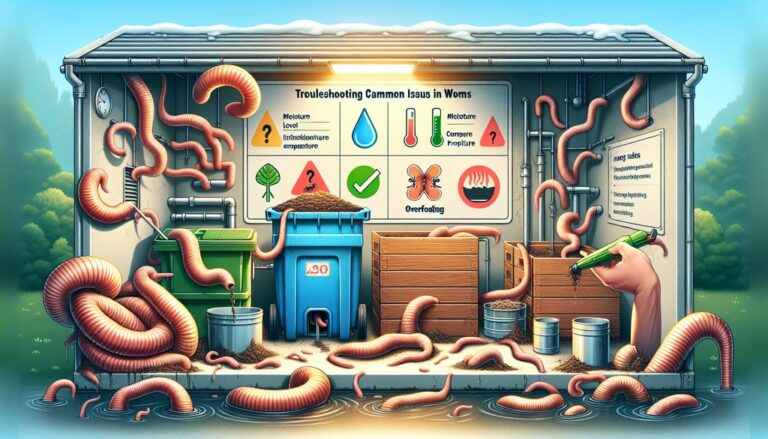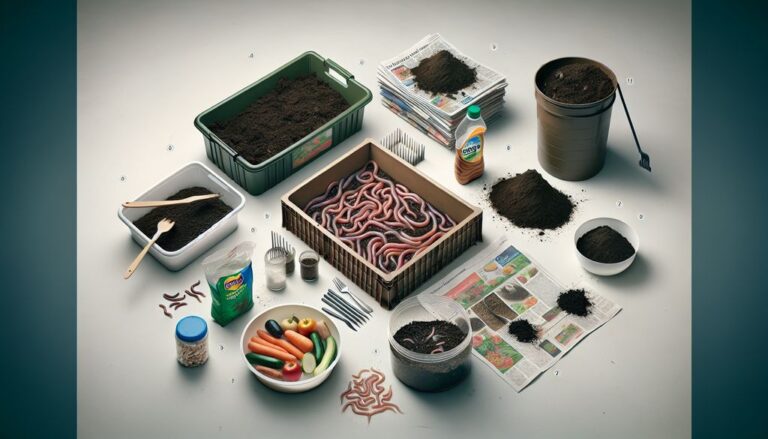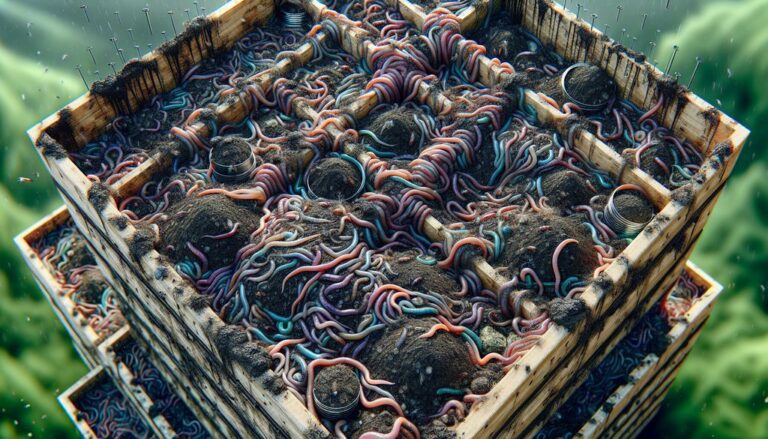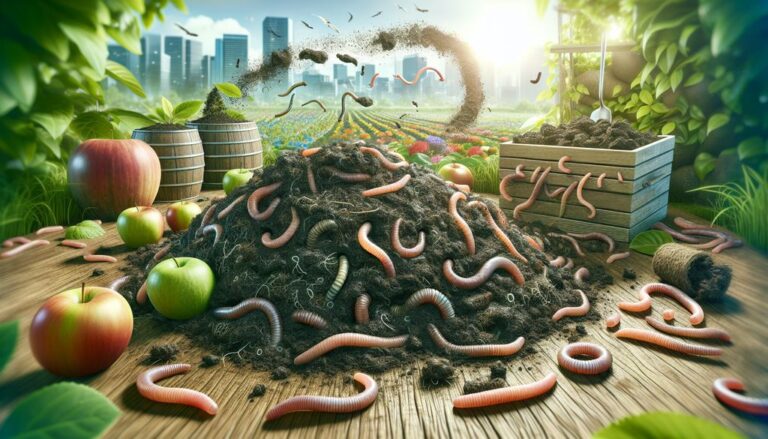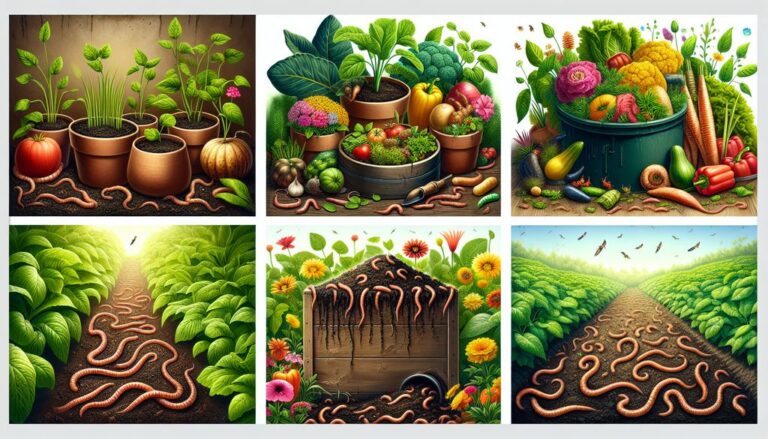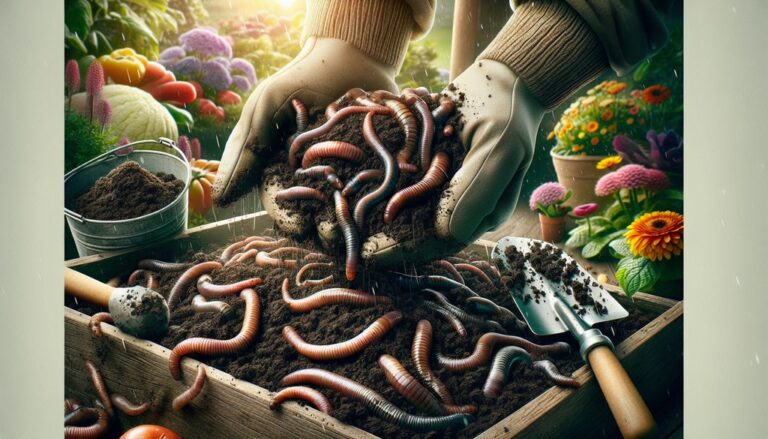As the world continues to seek sustainable solutions for managing organic waste, composting has emerged as a popular method. In this article, we will explore two innovative composting methods: vermicomposting and bokashi composting. These methods offer efficient and eco-friendly ways to convert organic waste into nutrient-rich compost, making them ideal for individuals with limited space or those composting in apartments. Let’s delve into the details of these sustainable solutions and uncover their key takeaways.
Key Takeaways
- Vermicomposting utilizes red wigglers to efficiently break down organic waste, making it an eco-friendly solution for reducing food waste and creating nutrient-rich compost.
- Bokashi composting is an anaerobic fermentation process that utilizes beneficial microorganisms to break down organic waste, including traditionally compostable items like cooked food scraps, meat, and dairy.
- Both vermicomposting and bokashi composting are ideal for individuals with limited outdoor space or those composting in apartments, offering sustainable solutions for managing organic waste.
- Red wigglers used in vermicomposting are highly efficient at breaking down organic matter and producing nutrient-rich compost, making it a cost-effective and eco-friendly method for creating soil amendments.
- By diverting organic waste from landfills, vermicomposting and bokashi composting contribute to reducing greenhouse gas emissions and creating a more sustainable future.
Sustainable Solutions for Organic Waste
Vermicomposting
Vermicomposting harnesses the natural process of decomposition with the help of worms, specifically red wigglers or earthworms, to convert organic waste into a valuable soil amendment known as worm castings or vermicompost. This method is ideal for indoor spaces and small-scale composting efforts, making it accessible to those living in apartments or with limited outdoor areas.
To begin vermicomposting, you’ll need a suitable container, bedding material such as shredded newspaper or coconut coir, and of course, composting worms. The process is straightforward:
- Prepare the bedding and moisten it to the consistency of a wrung-out sponge.
- Add the worms and start with a small amount of organic waste.
- Maintain the bin by keeping it in a dark, cool place and regularly adding more organic scraps.
The worms will eat through the waste, leaving behind their castings. Over time, the bin’s contents will transform into a rich, crumbly compost that resembles coffee grounds. Vermicompost is packed with nutrients and can be used to enrich garden soil, potted plants, or as a top dressing for lawns.
Vermicomposting not only diverts waste from landfills but also produces a high-quality compost that can enhance plant growth and soil health. It’s a win-win for the environment and gardeners alike.
Bokashi Composting
Bokashi composting is a unique method that allows for the inclusion of a wider variety of kitchen scraps, including meat, dairy, and citrus fruits, which are typically not recommended for traditional composting methods. It’s an effective way to reduce food waste and produce nutrient-rich soil amendments for your plants.
To begin Bokashi composting, you’ll need a specific setup:
- Buy or Make a Bokashi composting system: This usually includes a container with an airtight lid, a drainage tray, and a spigot.
- Prepare the Bokashi bran: A crucial element, Bokashi bran is a mix of microorganisms that ferment the waste. It can be purchased or homemade.
- Collect organic waste: Kitchen scraps like fruit and vegetable peels, coffee grounds, tea bags, and even small amounts of meat and dairy should be collected. Chopping them into smaller pieces can speed up the process.
The Bokashi process is an anaerobic fermentation that relies on beneficial microorganisms to break down the organic matter without the presence of air. This method is particularly suitable for urban settings or places with limited space, as it does not produce odors and can be done indoors.
Once you have your system set up and your materials collected, the process is straightforward. Layer your waste with Bokashi bran in the container, ensuring it’s compacted to remove air pockets. Drain the liquid that accumulates, which can be used as a plant fertilizer or drain cleaner, and after a few weeks, the contents can be buried in the garden soil or added to a traditional compost pile to complete the decomposition process.
Other Composting Methods
Beyond vermicomposting and bokashi, there are additional methods to manage organic waste sustainably. Backyard composting is a popular choice for those with outdoor space. It involves creating a compost pile or using a bin or tumbler, which requires regular turning and moisture monitoring. This method is great for incorporating both ‘green’ materials like fruit and vegetable scraps, and ‘brown’ materials such as leaves and cardboard.
To ensure a successful composting process, it’s important to maintain a balance between these materials:
- Green Materials: Provide nitrogen and include items like grass clippings and coffee grounds.
- Brown Materials: Supply carbon and include items like dry leaves and newspaper.
A well-maintained compost pile not only reduces waste but also produces rich soil amendments that benefit your garden.
For those with limited space, indoor composting options are available, such as electric composters that can fit under a kitchen sink. These devices accelerate the decomposition process, making composting convenient for urban dwellers. Remember, the key to effective composting is aeration, moisture, and a mix of green and brown materials, regardless of the method you choose.
Vermicomposting: A Next-Level Composting Method
How Vermicomposting Works
Vermicomposting harnesses the natural process of worm digestion to transform organic waste into nutrient-rich compost. The key players in this method are the red worms, specifically Eisenia fetida or Lumbricus rubellus, which are highly efficient at breaking down kitchen scraps and other organic materials.
To start vermicomposting, you’ll need a worm bin that is dark, well-ventilated, and has a lid, with drainage holes at the bottom. The bedding for the worms can be made from shredded newspaper, cardboard, or coconut coir, and should be kept as moist as a wrung-out sponge.
Vermicomposting is a sustainable method that doesn’t require much maintenance and can be done indoors, making it ideal for those with limited outdoor space.
Here’s a simple guide to setting up your vermicomposting system:
- Choose a suitable worm bin.
- Prepare moist bedding from shredded paper or coconut coir.
- Add red worms, starting with about 1 pound for a small bin.
- Feed the worms with organic waste, avoiding meat and dairy.
- Maintain the bin’s moisture and occasionally add new bedding.
The vermicompost will be ready when it looks like crumbly coffee grounds. At this point, you can harvest the compost by adding new bedding and scraps to one side of the bin, encouraging the worms to migrate, leaving the finished compost ready for use.
Benefits of Vermicomposting
Vermicomposting offers a multitude of advantages for both the environment and garden enthusiasts. Worms are incredibly efficient at converting organic waste into nutrient-rich compost, often eating their weight in food each day. Their castings, teeming with beneficial microorganisms, are a boon for plant growth. This method not only enriches the soil but also plays a crucial role in reducing food waste, thereby mitigating greenhouse gas emissions from landfills.
Vermicomposting is a sustainable practice that saves the Earth one worm at a time.
Moreover, it is a cost-effective alternative to chemical fertilizers. By investing in red wigglers, you can naturally enhance soil quality without incurring ongoing expenses. The vermicompost produced can be mixed into potting soil or garden beds, significantly improving soil fertility.
Here are some key benefits of vermicomposting:
- Eco-friendly: Reduces waste and greenhouse gas emissions.
- Soil health: Produces a natural fertilizer that improves soil structure.
- Cost savings: Less reliance on chemical fertilizers.
- Low maintenance: Requires minimal upkeep and can be done indoors.
Remember, composting is a long-term investment in the health of your garden and the planet. While it takes time to see results, the process is straightforward and requires little maintenance once set up.
Getting Started with Vermicomposting
Embarking on your vermicomposting journey is a rewarding way to turn your kitchen scraps into nutrient-rich compost. Begin with selecting the right worm bin, which should be dark, well-ventilated, and have a lid to create an ideal environment for your worms. A plastic or wooden bin with drainage holes at the bottom will suffice.
To prepare your bin:
- Moisten bedding materials like shredded newspaper or coconut coir until they feel like a damp sponge.
- Add about 1 pound of red worms (Eisenia fetida or Lumbricus rubellus) to the bin.
- Spread kitchen scraps over the bedding, avoiding materials that may cause odors, such as onions or garlic.
Maintain the moisture of the bin by adding water as needed, and ensure it’s kept in a dark place. Over time, the worms will convert the organic material into vermicompost. When the compost resembles crumbly coffee grounds, it’s ready to use. You can encourage the worms to move to a new area of the bin by adding fresh bedding and scraps to one side, making it easier to harvest the finished compost.
Vermicomposting is not only a sustainable practice but also a simple one that can be done indoors. It requires minimal maintenance and provides a continuous supply of organic fertilizer for your plants.
Bokashi Composting: Anaerobic Fermentation Process
Understanding Bokashi Composting
Bokashi composting is a unique method that allows for the composting of a broader spectrum of organic waste, including items like meat, dairy, and citrus fruits that are typically challenging for traditional composting methods. It’s an effective way to reduce food waste and produce nutrient-rich soil amendments for your plants.
The process involves an anaerobic fermentation that relies on a special ingredient known as Bokashi bran, which is a mixture of microorganisms. These microorganisms are responsible for breaking down the organic matter in a way that doesn’t produce foul odors and accelerates the composting process.
Bokashi composting systems are generally composed of a container with an airtight lid, a drainage tray, and a spigot, making it a compact and convenient option for indoor composting.
To get started, you’ll need to prepare or purchase Bokashi bran and begin collecting your kitchen scraps. The scraps should be cut or chopped into small pieces to enhance the fermentation process. Once you have your system set up, you can look forward to creating a valuable soil amendment that can greatly benefit your garden.
Materials for Bokashi Composting
To begin Bokashi composting, you’ll need a few key materials. A Bokashi composting system is essential; it typically includes a container with an airtight lid, a drainage tray, and a spigot to release liquids. The heart of the Bokashi process is the Bokashi bran, a special mixture teeming with effective microorganisms (EM) that facilitate the fermentation of your organic waste. You can purchase ready-made Bokashi bran or create your own by fermenting wheat or rice bran with an EM solution.
Your organic waste is the next crucial component. This includes kitchen scraps like fruit and vegetable peels, coffee grounds, tea bags, and even small amounts of meat and dairy. It’s beneficial to chop these scraps into smaller pieces to expedite the fermentation process.
Remember, the success of Bokashi composting lies in the layering. You’ll alternate layers of organic waste with generous sprinklings of Bokashi bran, compacting each layer lightly to remove air pockets and ensure thorough contact with the bran.
By gathering these materials and following the proper layering technique, you’re well on your way to transforming your kitchen waste into a valuable soil amendment.
Steps for Bokashi Composting
After setting up your Bokashi composting system and preparing the Bokashi bran, you’re ready to begin the composting process. Ensure all organic waste is cut into small pieces to accelerate fermentation. Here’s a simple guide to follow:
- Layer your scraps: Start by placing a layer of waste in the Bokashi bin, then sprinkle a handful of Bokashi bran over it.
- Press down: Compress the waste to remove air pockets and seal with another layer of bran.
- Repeat: Continue layering and pressing until the bin is full.
- Drain liquid: Regularly drain the liquid produced, which can be diluted and used as plant fertilizer.
- Seal and wait: Once full, seal the bin and let it sit for two weeks to ferment.
- Bury or transfer: After fermentation, the contents can be buried in the garden or transferred to a traditional compost pile to complete the breakdown process.
Remember, the key to successful Bokashi composting is the absence of oxygen, so keep the lid tightly closed at all times. This method is particularly effective for items like meat and dairy, which are not typically suited for other composting methods.
By following these steps, you’ll contribute to reducing food waste and creating a valuable soil amendment for your garden. Bokashi composting is a practical and sustainable solution that fits well within the urban lifestyle, where space and composting options may be limited.
Conclusion
In conclusion, organic waste management is a crucial aspect of sustainable living. Through methods such as traditional composting, vermicomposting, and bokashi composting, individuals can effectively reduce waste and create nutrient-rich compost for their gardens. These methods not only benefit the environment by reducing greenhouse gas emissions but also provide a cost-effective and eco-friendly solution for managing organic waste. By embracing DIY composting, individuals can contribute to a more sustainable future and make a positive impact on the environment. Start composting today and be a part of the solution to reduce waste and promote sustainability.
Frequently Asked Questions
What is vermicomposting?
Vermicomposting is a composting method that uses worms to break down organic waste into nutrient-rich castings. It is an eco-friendly and space-efficient way to manage organic waste.
How does vermicomposting work?
Vermicomposting works by utilizing red wrigglers to consume organic matter and produce nutrient-rich compost. The worms aerate the compost, eliminating the need for manual turning.
What are the benefits of vermicomposting?
The benefits of vermicomposting include efficient decomposition, reduction of waste, and cost-effectiveness. It also helps in creating a more sustainable future by diverting organic waste from landfills.
What materials are needed for vermicomposting?
To start vermicomposting, you will need a container for housing the worms, bedding material, and organic waste such as kitchen scraps and plant trimmings.
What is bokashi composting?
Bokashi composting is an anaerobic fermentation process that uses beneficial microorganisms to break down organic waste, including cooked food scraps, meat, and dairy.
How does bokashi composting work?
Bokashi composting works by fermenting organic waste using a mix of beneficial microorganisms. It is a suitable method for composting traditionally non-compostable items.

